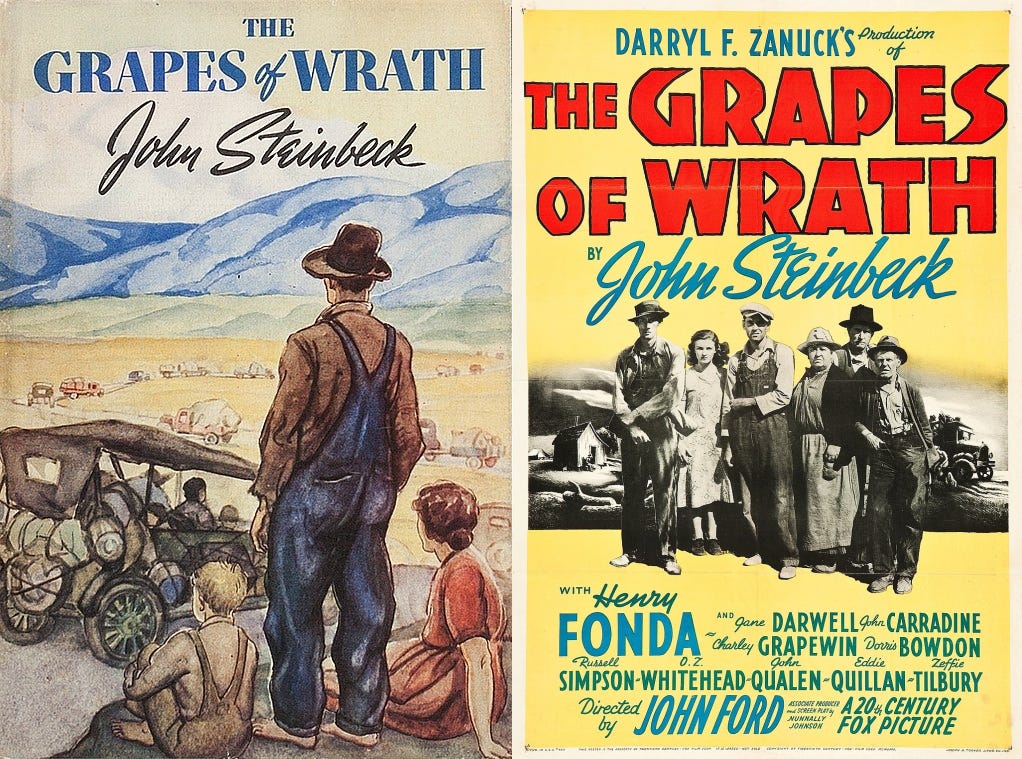The Mysteries of History (May 6 Edition)
FDR's WPA; Swastikated Hindenburg; Steinbeck's Grapes of Wrath
1935 — WPA Created
public domain images from wikimedia commons
On this day in 1935, in the midst of the Lousy (“Great”) Depression, U.S. President Franklin Delano Roosevelt (FDR) brought the Works Progress Administration (WPA) into being.
This initiative put three million unemployed men in the Country to work. This was not “busywork” or a hand-out, as they were put to work building, improving, or maintaining airports, highways, hospitals, parks and playgrounds, schools, and even at least one ski resort. The WPA also put “artistic types” to work painting murals, writing and presenting plays, and creating State-specific guidebooks, among other things.
By means of this and other measures, a government-sponsored jolt to the personal economy of those men and their families and to the Nation as a whole was accomplished.
Questions: Did you have family in the USA in the 1930s? If so, were any of them employed in WPA projects?
1937 — Hindenburg Dirigible Disaster
public domain images from wikimedia commons
Thirty-six passengers and crew members perished on this day in 1937 when the largest dirigible ever built, the Hindenburg, burned and crashed. The burn came first, as fire erupted when the unwieldy-looking craft struck its mooring mast, causing the airship to break up and collapse to the ground.
The Hindenburg was 804 feet long (almost three endzone-to-endzone football fields in length). There were 97 people aboard, 35 of whom died in the fiery tragedy; the 36th victim was a member of the ground crew. As the Hindenburg was quickly incinerated, most of the 62 survivors suffered serious injuries.
Dirigibles were the vehicles used for the first transatlantic passenger air service. Accidents such as this one and the one from a little more than two years previous (also in New Jersey), written of in the April 4th edition of this series here, made the traveling public leery of using this mode of transportation, causing this form of travel to be viewed not just as dangerous but eventually quaint and rather surrealistic-seeming, relegating it to the list of history’s failed or rejected experiments.
Questions: The top image above was taken a few hours before the explosion; why was a dirigible with Nazi symbols (swastikas) not a cause for concern for the citizens at the time? Have you ever ridden in a dirigible? If not, would you want to? Why or why not? Have any of your ancestors (parents, grandparents, etc.) ever been in one?
1940 — Steinbeck Wins Pulitzer
public domain images from wikimedia commons
John Steinbeck (1902-1968) won the Pulitzer Prize on this date in 1940 for his book The Grapes of Wrath. It also won the National Book Award.
Steinbeck’s title for the depression-era story was gleaned from the Civil War-era song Battle Hymn of the Republic (“Mine eyes have seen the glory of the coming of the Lord; He is trampling out the vintage where the grapes of wrath are stored ...”).
When Woody Guthrie came out with his song This Land Is Your Land, also in 1940, Steinbeck quipped that had he known his friend was going to write that song, he wouldn’t have had to write his epic novel and thus been saved a lot of time and effort.
Questions: What did Steinbeck mean about This Land is Your Land basically making the same point as The Grapes of Wrath in just a few minutes? Which Steinbeck books have you read (please don’t say “None”!)? What is your favorite Steinbeck book? What is your favorite movie made from a Steinbeck novel: The Grapes of Wrath? Of Mice and Men? East of Eden? Tortilla Flat? In Dubious Battle? or another one? Have you seen the Longmire episode “Help Wanted” (Season 3, Episode 5)?
Read about “The Secret Lives of Kids” here.









